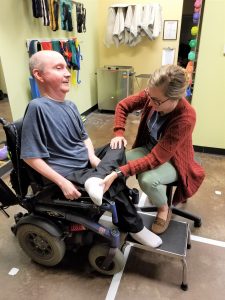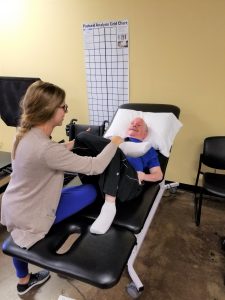Stretching Lower Extremities of SMA Patients

Your typical SMA patient spends much of their day sitting in a wheelchair. While this may be normal for them, it can cause problems with muscle tightness and soreness during their typical day. My patient, Michael, was diagnosed with severe hip, muscle, and nerve damage in his right hip and leg in 2018, which has caused him to experience discomfort in his right lower extremity daily. In late 2018, and all throughout 2019, we have been working with Michael to stretch out muscles in his legs and hips so that we can relieve some of the soreness he feels. Every month, we spend two weeks working with Michael while he’s on the therapy table, and the other two weeks, we work with him while he’s sitting in his wheelchair. In the following pictures, I will explain the different stretches that we go through. These are simple and can be easily modified for specific patients and their needs. These stretches are very helpful for Michael and they can also be beneficial for anyone who sits in a wheelchair for most of the day.
In the 1st set of pictures, listed below, I’m working with Michael while he’s sitting in his wheelchair. When he’s in his wheelchair, we focus on core and neck strengthening exercises for the majority of the time, but we use the last 5 or 10 minutes of these therapy sessions to work on stretching the muscles in his hips.
In PIC #1, I place Michael’s left foot flat on the stepstool, which elevates his left leg slightly higher than his normal sitting position. After this, I lift Michael’s right foot and place it on top of his left knee. Once his right leg is in a crossed position, I stabilize his right foot with my right hand to maintain the position. I then take my left hand and place it on Michael’s right knee. Once Michael is in a comfortable position, I began pressing in a downward motion on his right knee. This places him in an externally rotated position which stretches his internal rotators of the hip including tensor fasciae latae (TFL), gluteus minimus, and gluteus medius. We hold the stretch for approximately thirty seconds and then push further into external rotation. We typically do this for about 2 or 3 minutes, and afterwards, any discomfort that Michael may have been feeling in his right hip greatly diminishes.

In PIC #2, I slowly push Michael’s right foot closer to his body with my right hand, and I lift his right knee and push it toward his chest with my left hand. This places him in an internally rotated position stretching out his external rotators, such as his piriformis.

In PIC #3 & PIC #4, I’m performing the same stretches on Michael’s left leg. After completing these stretches during the weeks that he’s in his wheelchair, Michael usually feels instant relief from any muscle tightness. If he starts to experience any discomfort during the week, his caregivers can perform the same stretches at home while he is seated in his wheelchair.


In the 2nd set of pictures, listed below, (PIC #5, #6, #7 & #8), we are working with Michael while he’s laying supine on the physical therapy table. While we perform the same stretches as we do when Michael is in his wheelchair, having him in a reclined position allows for further range of motion. As you can see, there are several ways to modify these stretches by using different equipment to place his hips in a more flexed position while stretching.




The consistent stretching that we have done for Michael have proven beneficial in not only his daily comfort, but also in his quality of life. He no longer suffers chronic daily pain since beginning these stretches. Typically, after performing these stretches during his physical therapy sessions, he doesn’t experience any discomfort or pain for at least 3 or 4 days after each session. When he starts to get uncomfortable between sessions, his caregivers stretch him out at home, which has helped him tremendously. We continue to work on Michael’s flexibility each week to continue to decrease his pain and improve his daily life. These exercises are simple to perform and easy to modify to meet specific patients needs and decrease pain from sitting all day in one position. These stretches can be used on a wide variety of patients with many different diagnoses.



